The Lowdown on Low Voltage Power Distribution Equipment
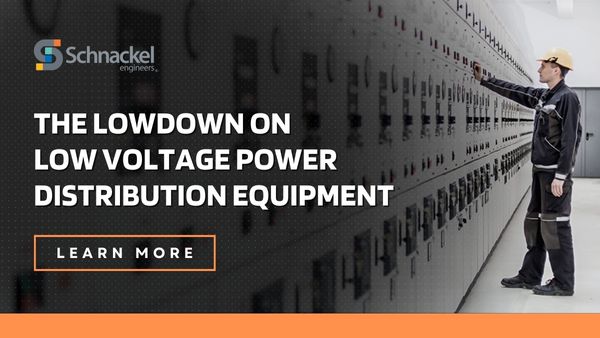
The American National Standards Institute (ANSI) classifies low voltage as a power system that operates at 600 volts or less. Nearly every building requires scores of electrical circuits that operate at 600 volts or less. To serve these electrical circuits, low voltage power distribution equipment serves as the lifeblood of any building’s electrical distribution system. In this blog, we’ll focus on providing a high level description of the most common types of low voltage power distribution equipment found in nearly every building: panelboards, switchboards, safety switches, and transformers.
Common Types of Low Voltage Power Distribution Equipment
Panelboards
Panelboards are the most common piece of low voltage power distribution equipment found in nearly every facility. They divide a single large circuit into smaller circuits. Panelboards are typically standardized pieces of equipment, meaning their characteristics are relatively fixed.
Panelboards are subdivided into two voltage classes, 240 volts and 600 volts. The 240 volt class panelboards are designed to serve circuits that do not exceed 240 volts, meaning they are typically used on 208 volt or 240 volt systems. Similarly, 600 volt class panelboards are designed to serve circuits that do not exceed 600 volts. As such, 600 volt panelboards can be applied to 208 volt, 240 volt, 480 volt, and 600 volt systems. However, applying a 600 volt class panelboard on a 208 or 240 volt system is uncommon due to the increased cost of 600 volt class equipment.
There are three types of panelboards: lighting and appliance panelboards, load centers, and power panelboards.
A lighting and appliance panelboard typically serves as the final distribution point in a commercial or industrial facility’s low voltage power distribution system to serve loads, such as receptacles, lighting, and other equipment, that is typically rated at 100 amps or less. Nevertheless, lighting and appliance panelboards can also serve as the primary or an intermediate distribution point of a small facility. These panelboards are typically rated up to a maximum of 600 amps while the most common circuit breaker used in these panelboards is rated at 20 amps. Lighting and appliance panelboards are typically 20 inches wide by 5.75 inches deep and their height will vary depending on the number of circuits the panelboard serves.
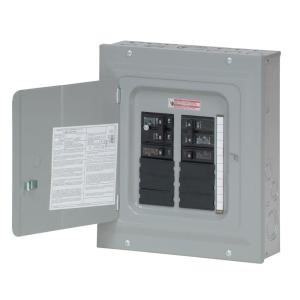
A load center is similar to a lighting and appliance panelboard but is typically reserved for use in single- or multi-family residential projects and are typically rated up to a maximum of 225 amps. A load center can be viewed as a residential-grade lighting and appliance panelboard. Nevertheless, load centers can be applied in a commercial or industrial setting. Because they are designed for primarily residential use, load centers are typically 14.25 inches wide by 3.75 inches deep, which allows them to fit within the stud cavity of typical residential construction.
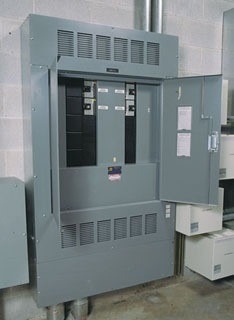
Power panelboards are designed to serve loads that are too large to be accommodated by a lighting and appliance panelboard, typically greater than 100 amps up to a maximum of 1,200 amps. They are often used as an intermediate power distribution point, but can also serve as the primary power distribution point of a small- to medium-sized facility’s power distribution system. Power panelboards are typically rated between 400 amps and 1,200 amps. The physical dimensions of power panels vary depending on the rating of the panelboard and the ratings of the overcurrent protective devices (circuit breakers or fuses) installed within, but will typically range from 24 to 48 inches wide by 8 to 16 inches deep.
Switchboards
A switchboard is designed to serve loads that exceed 1,200 amps. Switchboards are typically used to distribute power to other switchboards, panelboards, or large electrical loads and often serve as the primary power distribution point of a medium- to large-sized facility’s power distribution system. They are typically rated 1,600 amps to 5,000 amps and are characterized by two or more vertical sections of equipment mounted side-by-side.
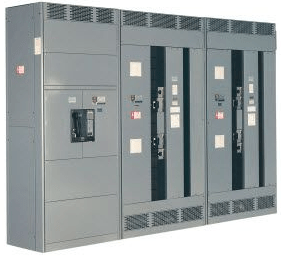
The physical dimensions of switchboards can vary wildly. The depths will typically range from 24 inches deep to 60 inches deep depending on the ampere rating of the switchboard’s bus, while the lengths can reach 20 feet or more.
Unlike panelboards, switchboards are custom pieces of equipment and are always engineered-to-order (ETO).
Safety Switches
Safety switches are commonly referred to as “disconnect switches.” They are commonly found installed adjacent to motors and mechanical equipment and are typically used to de-energize the equipment they serve so that maintenance can be performed on the equipment.
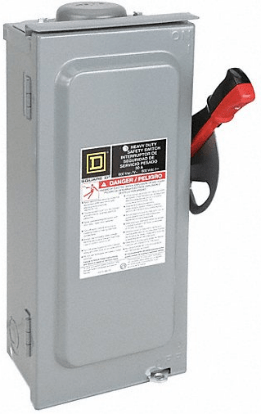
Safety switches are available in either fused or non-fused versions. The fused versions incorporate fuses to provide overcurrent protection for the equipment, while the non-fused versions merely act as an ON/OFF switch.
Safety switches are available in ratings of 30 amps, 60 amps, 100 amps, 200 amps, 400 amps, 600 amps, 800 amps, and 1,200 amps. The physical dimensions vary depending on these ratings.
Like panelboards, safety switches are subdivided into a 240 volt class and a 600 volt class.
Transformers
Transformers are used to change power from one voltage to another voltage and can be used in either a step-up or step-down application. The most common application for a transformer within a commercial building is to change 480 volt power to 208 volt power.

The physical dimensions of transformers vary depending on the power rating of the transformer, and they are typically seen sitting on the floor, mounted to a wall, or suspended on a trapeze from the structure above.
Obsolescence and Dangerous Equipment
When attempting to reuse existing panelboards or switchboards, consideration needs to be given to whether the existing equipment manufacturer is still in business and whether the equipment has been deemed to be inherently dangerous.
Obsolescence
Currently, there are four major manufacturers of low voltage power distribution equipment: ABB/GE, Eaton/Cutler-Hammer, Schneider Electric/Square D, and Siemens. This is an important consideration when attempting to reuse existing panelboards and switchboards because existing panelboards or switchboards made by manufacturers that do not currently exist may prove to be a problem sourcing parts and circuit breakers for.
Most panelboard and switchboard parts for obsolete manufacturers are typically only available as aftermarket parts and are expensive. In many instances, replacing an entire panelboard will prove to be less expensive than buying aftermarket parts for a piece of obsolete equipment.
Dangerous Equipment
Some panelboards manufactured by extinct manufacturers have been found to be inherently dangerous, mostly due to circuit breakers that do not trip or busses that overheat. These include panelboards manufactured by Challenger, Federal Pacific Electric with Stab-Lok® circuit breakers, Pushmatic/Bulldog, Sylvania/GTE, and Zinsco.
It is recommended to avoid contact with these panelboards when encountered. These panelboards should always be replaced.
Conclusion
Low voltage power distribution electrical equipment is vital to any building’s power distribution system. Knowing how each piece of distribution equipment fits in and how to correctly apply the correct piece of equipment is critical to ensure an efficient, safe, and economical power distribution system.
Contact Schnackel Engineers today to see how we can help design and specify your new low voltage power distribution equipment, or to evaluate your existing equipment.
Comments